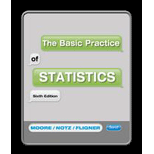Sorry! We don’t have solutions for this edition yet.
Solutions are available for other editions of this book
View 8th Edition solutionsarrow_forwardView 7th Edition solutionsarrow_forwardBook Details
The Basic Practice of Statistics (BPS) is designed to give a working knowledge of the ideas and tools of practical statistics. Through accessible language and engaging examples and exercises based on real data, BPS explains both the mechanics and the concepts needed for statistical work. The Sixth Edition maintains the textbook's focus on statistical reasoning and real-life situations and data, while updating the organisation, exercises and examples to better reflect the needs and experiences of today's student. Here are a few highlights of the revised Sixth Edition: Updated Exercises and Examples: More than 20 percent of all examples and exercises have been revised or updated. Contemporary situations and up-to-date data cover a number of fields, including environmental studies, agriculture, business and finance, technology, biology, psychology, health and medicine, education, sports, and entertainment. New examples and exercises draw on topics such as texting while driving, CO2 emissions, the Gulf oil spill, and how weather influences tipping. Each chapter also features a new set of 'Exploring the Web' exercises that encourage readers to go online to analyze data, investigate statistical issues, and learn about new applications of statistics. Improved coverage: In addition to updates and improvements to coverage throughout the text, the topic of inference has been expanded to include separate chapters on confidence intervals (Chapter 14), tests of significance (Chapter 15), and inference in practice (Chapter 16). The revised format allows students to focus on the basics of each procedure separately before discussing cautions about the use of both in practice. Helpful navigation: Chapter summaries now consist of two sections: The first section, 'Chapter Specifics,' summarizes the material presented in the chapter. The second section, 'Link It,' relates the chapter content to material in previous and upcoming chapters. Together, 'Chapter Specifics' and 'Link It' show how individual chapters relate to one another and to the overall practice of statistics.
More Editions of This Book
Corresponding editions of this textbook are also available below:
